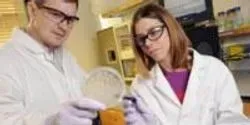biochemistry

Facing a challenge akin to solving a 1,000-piece jigsaw puzzle while blindfolded—and without touching the pieces—many structural biochemists thought it would be impossible to determine the atomic structure of a massive cellular machine called the nuclear pore complex (NPC), which is vital for cell survival.

Georgia Institute of Technology researchers have developed a novel method for improving silicon-based sensors used to detect biochemicals and other molecules in liquids. The simplified approach produces micro-scale optical detection devices that cost less to make than other designs, and provide a six-fold increase in sensitivity to target molecules.

A new class of synthetic platelet-like particles could augment natural blood clotting for the emergency treatment of traumatic injuries – and potentially offer doctors a new option for curbing surgical bleeding and addressing certain blood clotting disorders without the need for transfusions of natural platelets.

High resolution X-ray crystallography is an imaging technique in which X-ray beams are shot through purified, crystallized proteins. The beam scatters in different directions, allowing scientists to construct a detailed, 3-D model of the crystallized protein's molecular structure. Measuring the intensities and angles of the diffracted beams reveals the position of each atom in the protein.













